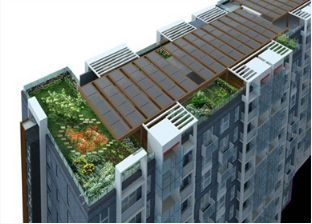
Contact Us: 020-31125660 Fax: 020-23889671
Wecome to Guangdong Eacoon Energy Technology Stock Co.,Ltd. website
SOLUTIONS |
Intelligent Eco-energy-saving Building Project
In terms of construction engineering, energy is consumed from time to time, from the production and use of engineering building materials, to the construction of engineering buildings, to the use of construction projects. According to the survey, the annual construction volume in China has reached more than 2 billion square meters, equivalent to 40% of the total annual global construction. However, 95% of the existing buildings in China are non-energy-saving buildings. China's annual consumption of cement, glass and steel accounts for 40%, 45% and 35% of the world's total. In China, which is in the period of high-speed urbanization, the per capita energy consumption has increased significantly, which has made China's building environmental protection and energy conservation face enormous challenges. However, the rapid increase in the scale of construction during this period is also an opportunity for China to implement building energy-saving measures, and it also forces China to accelerate the implementation of energy-saving and environmental protection systems in buildings. 1. The application of solar energy in building technology Solar energy is the cleanest, most convenient and convenient green energy that we humans can apply. Solar energy has many functions of environmental protection and energy conservation: solar cell power generation system is installed on the roof of the building, which can convert the solar radiation heat energy into electric energy. The battery pack of the equipment stores the electric energy and connects the relevant lines to the corresponding power supply equipment. Fundamentally meet the power demand of the power and lighting system in the building; solar heating, insulation and heating functions can meet the daily heating needs of buildings; solar technology can also control the lighting of buildings It is conducive to the daily energy-saving applications of buildings. The use of solar energy is an application technology that is most suitable for building energy conservation and environmental protection. It has the characteristics of safe and reliable, no pollution, no fuel consumption, no environmental restrictions, simple maintenance and repair, and convenience device. Regarding the selection of solar energy building technology, it can be tailored according to the climate characteristics of different regions in China. As for the construction of northern cities, due to the cold winter in the north, it is necessary to improve the insulation performance of buildings, give full play to the heat source efficiency of buildings, and take certain measures to reduce heating energy consumption. Actively improve the conditioning function of heating equipment. As for the buildings in the southern cities, due to the hot and humid weather in the south, improving the natural ventilation technology and shading technology of the buildings is the key point, thus reducing the energy consumption of the buildings, achieving the environmental protection effect and ensuring the buildings. Normal use. 2. Water saving technology is applied in construction At this point, there are many outstanding building technologies in foreign countries that are worthy of reference and reference. Singapore has a reputation as a “garden city”. Its roof garden rainwater utilization system is one of the important ways to reduce urban storm runoff, control non-point source pollution and beautify the city. It can also be used as a pretreatment measure for rainwater accumulation. In order to ensure that the roof garden is not leaking and the roof sewer is smooth, consider adding water and drainage measures to the planting area and water body of the roof garden. In the selection of plants and upper soils, plants should be determined according to local climatic conditions, and should also match soil type and thickness. The upper soil should be selected from clean natural or artificial materials with high void ratio, low density, erosion resistance, and plant growth. The roof garden system can effectively reduce the amount of rainwater lost, and at the same time improve the ecological environment of buildings and even cities. At the same time, the condensed water of domestic sewage, rainwater and indoor air conditioning tuyere is collected and treated by rainwater storage and collection system, sedimentation filter tank and pipeline, and is widely used in greening and landscape water. It is also possible to use the reclaimed water discharged into the river from the sewage treatment plant around the building to construct a “regeneration water source heat pump system” to extract the temperature energy of the reclaimed water to provide residents with winter heating and summer cooling. It can save a lot of investment in power facilities, make full use of water resources many times, realize the maximum use of resources and the harmonious coexistence of people and the environment. In another area of water waste, drinking water, each household should be equipped with a direct drinking water system, connect the household water system pipe directly to the water purifier, and directly drink it through the filtration system. This not only avoids the secondary pollution of the central drinking water, but also saves a lot of water for cleaning the water pipeline and other water transportation facilities. 3. Application of new materials in construction As early as the 2000 World Expo, the Japan Pavilion was a temporary paper building used during the World Expo. After the meeting, most of its materials could be recycled. It focuses on the characteristics of materials and structures, focusing on resources and environmental issues. It uses recycled paper to form a arched structure, which is made up of 12.5 cm thick paper tube mesh. The curved roof and wall materials are also fabric and paper. During the day, the natural light passes through the translucent paper window to form a soft and pleasant indoor light environment; at night, the paper window is the "screen" of magical light and shadow, which is amazing. The application of energy-saving, environmentally friendly and efficient new materials is one of the biggest highlights of this Shanghai World Expo. Known as the “Oriental Crown”, the China National Pavilion uses domestically produced high-performance fluorocarbon coatings for up to 20 years. The Expo shaft, which is 1045 meters long and 100 meters wide, is the largest single project in the park. The giant overpass is a "white cloud" with high-strength polytetrafluoroethylene (PTFE) material. Walking into the European Pavilion area of the Expo Park, most people will be shocked by the Spanish Pavilion. This building is like the “rattan basket”. The building materials are the most environmentally friendly and traditional. The building means is the most advanced and pioneering. of. According to Javier Gonde, the general representative of the Spanish Pavilion, rattan design is a trend in architecture, and there is no problem in terms of moisture prevention and fire prevention. Moreover, the sun shines through the gaps of the rattan and sprinkles inside the exhibition hall, greatly reducing the lighting energy consumption. In the Madrid Pavilion of the Urban Best Practices Area, the “Bamboo House” is a rectangular building. The shading and ventilation functions of the bamboo skin will be fully utilized and the ecological temperature control effect will be achieved. ” 4. Application of new building structure The current situation of the planning and construction of residential quarters and structural layout in China is worrying. Most residential buildings are far from enough to consider the factors of “sustainable development”, mainly staying in the stage of stereotype design, lack of plasticity, and it is difficult to adapt to changes in family structure. Moreover, the construction of residential quarters has broken through the environmental carrying capacity. The problem of handling solid, liquid and gaseous waste in the community has basically remained passive and passive. It is completely dependent on the digestion and absorption capacity of the natural environment itself, and lacks artificial control and management. In the future, residential buildings need to adopt a flexible modular structure with a large opening. After the family structure and lifestyle changes, the system can adjust or change the layout, function and size of the housing set to meet the needs of different families and individuals to meet people's adaptability requirements for future homes. The design of the building is no longer based on the existing cityscape space, but rises to a higher level. For example, the kayaoi University campus building designed by bakoko in Japan, the roof is no longer just a valuable leisure space, there are many lasting benefits: soil and biomass contribute to the isolation of the building, not only to cool and cool, but also It can reduce rainwater runoff. Trees and natural vegetation cultivated on the roof enrich the diversity of living things. The latest perforated concrete vault frame, curved form, optimizes its compressive strength and at the same time acts as a breather. In order to allow fresh air and natural light to enter the interior of the building, the roof is also designed with vents. There is no wind trap at the vault, but it can reflect and diffuse artificial light through a double curved ceiling. |


